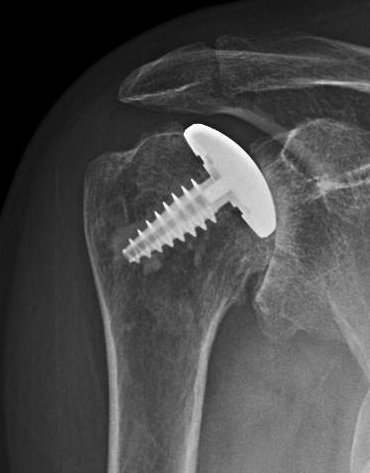He was treated with a hemicap at another institution.
Because of pain and a sensation of crepitance, he presented to our service. Physical examination revealed a limited range of motion with a grinding that was palpable. His x-ray at presentation to us is shown below, demonstrating contact between the unresurfaced portion of the arthritic humeral head and the glenoid.
This finding was verified at surgery as shown below - note the prominent bone beneath the hemicap.
This was revised to a traditional hemiarthroplasty, which replaced the arthritic humeral joint surface with a smooth prosthetic humeral head secured by an impaction grafted stem in the medullary canal. No glenoid arthroplasty was required. The postoperative x-rays are shown below.
Immediately after surgery the shoulder demonstrated improved range of motion without crepitance.
Comment: A smaller implant is not necessarily more conservative. The structural properties of the metal hemicap are quite different from the neighboring bone. Incomplete resurfacing of the humeral articular surface risks contact between arthritic humeral bone and the glenoid.
===
To see the topics covered in this Blog, click here
Use the "Search" box to the right to find other topics of interest to you.
You may be interested in some of our most visited web pages including:shoulder arthritis, total shoulder, ream and run, reverse total shoulder, CTA arthroplasty, and rotator cuff surgery as well as the 'ream and run essentials'






